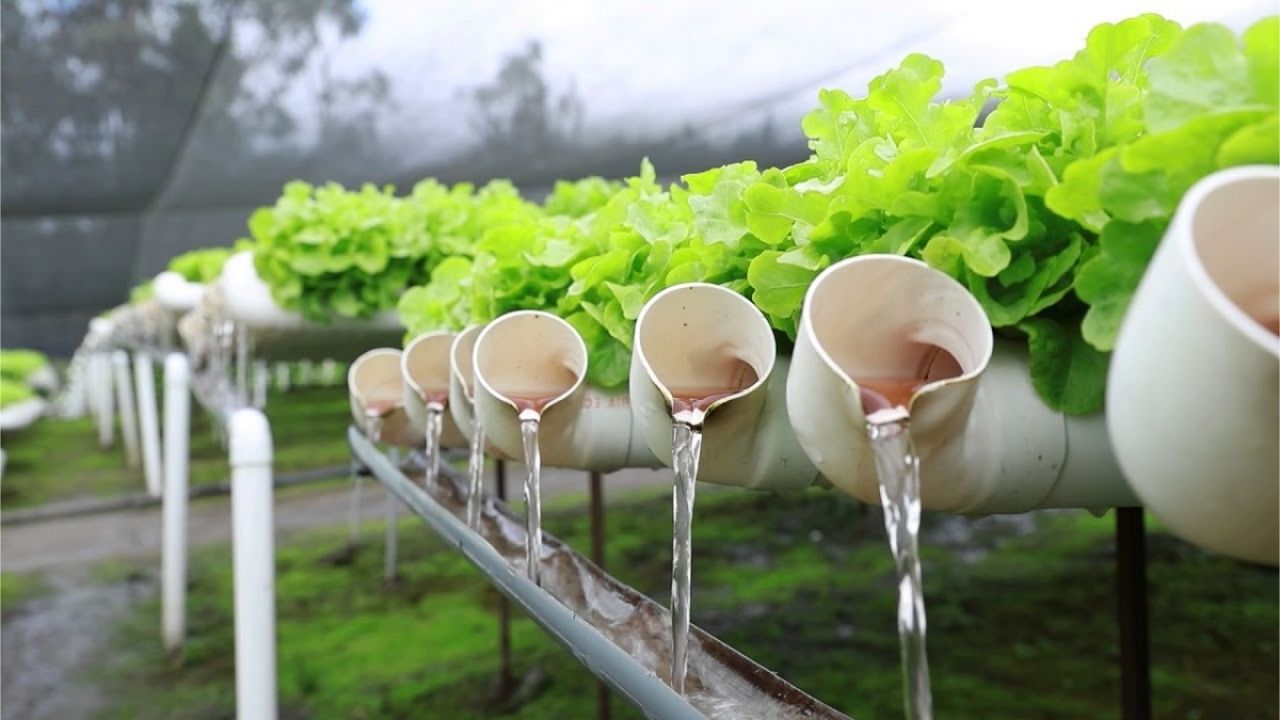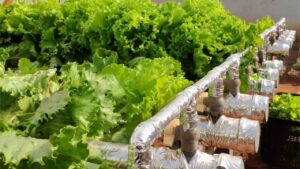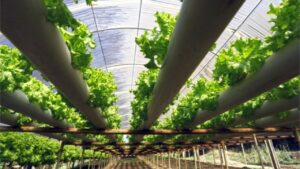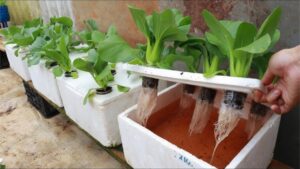Cities are increasingly becoming the epicenter of significant changes across various sectors, and urban agriculture is one of the fastest-growing fields. In this context, hydroponic gardens have emerged as a modern and efficient solution for producing fresh food in limited spaces. This technique, which eliminates the need for soil by using nutrient-rich solutions, has gained popularity not only on rooftops and balconies but also within tech startups and large urban centers.
Technological advancements have been essential in making these initiatives viable. Smart sensors, automated systems, and state-of-the-art lighting are revolutionizing the way we grow food in cities. These innovations enable real-time monitoring and optimization of plant growth, making the process more efficient and accessible, even for those living in compact spaces.
Beyond the practical benefits, urban hydroponic gardens have a significant environmental and social impact. They help reduce water waste, minimize carbon footprints by cutting down on food transportation needs, and foster a closer connection between people and the source of their food. By doing so, they are contributing to a more sustainable future that aligns with the demands of urban life.
Why Hydroponic Gardens?
Hydroponics is a plant cultivation technique that eliminates the need for soil. Instead, plant roots are immersed in a nutrient-rich solution that provides everything they need to grow healthily and efficiently. This method allows for precise control over the factors that affect plant development, such as water, light, and nutrient levels.
One of the biggest advantages of hydroponics over traditional gardening is resource efficiency. This system uses up to 90% less water, as the nutrient solution is recycled within the system. Additionally, hydroponic cultivation requires much less space, making it ideal for urban areas where every square meter counts. Efficiency is another key highlight: since plants receive exactly what they need, they grow faster and yield more.
These characteristics make hydroponics a perfect solution for urban environments. With increasing population density in cities and growing demand for fresh, locally sourced food, hydroponic gardens offer a sustainable alternative. They can be set up in small apartments, on rooftops, or even inside containers, seamlessly adapting to the pace and constraints of urban life. Moreover, they help reduce reliance on traditional supply chains, providing fresher and healthier food directly within the city.
Key Technologies Making a Difference
Urban hydroponic gardens are benefiting from a range of technological innovations that make cultivation more efficient, sustainable, and accessible. Below are the key technologies revolutionizing this sector:
Smart Sensors and IoT (Internet of Things)
Smart sensors are transforming the way plant conditions are monitored in real-time. They precisely measure nutrient levels, pH, humidity, and temperature, providing critical data to fine-tune the system automatically. Integrated with IoT, these sensors allow growers to manage their gardens remotely through apps, ensuring maximum performance with minimal effort.
Advanced LED Lighting Systems
Next-generation LED lighting is redefining artificial light. With the ability to simulate sunlight across different spectrums, these systems optimize plant growth in any environment, regardless of natural light availability. Additionally, they are highly energy-efficient, reducing operational costs significantly.
Automation and Robotics
Automated and robotic solutions are removing the need for manual intervention in many cultivation stages. Automated irrigation systems ensure plants receive the right amount of water and nutrients, while robots can perform tasks such as harvesting quickly and accurately. This automation boosts productivity and reduces the margin of error.
Big Data and Artificial Intelligence
Data analysis plays a crucial role in improving hydroponic practices. Using Big Data and Artificial Intelligence, growers can predict the best times for planting and harvesting and identify patterns to maximize system efficiency. These technologies make cultivation more strategic and evidence-based, rather than relying on trial and error.
Sustainability Technologies
Sustainability-focused solutions are a cornerstone of modern hydroponic gardens. Systems that recycle water used in cultivation reduce waste, while integration with renewable energy sources, such as solar panels, makes operations even more eco-friendly. These innovations help create an agricultural system that respects the environment without sacrificing productivity.
Together, these technologies are shaping the future of hydroponic gardening, making it possible to grow fresh and healthy food efficiently and sustainably, even in the most challenging urban environments.
- See Also: Main Challenges of Urban Hydroponics and How to Overcome Them
- Follow Us: https://www.facebook.com/profile.php?id=61565415975218
Success Stories
Urban hydroponic gardens that have adopted advanced technologies are showing impressive results, transforming the way food is grown in cities. Below are some real-life examples demonstrating the impact of these innovations.
Sky Greens Vertical Farm, Singapore: Sustainability in Limited Spaces
With limited agricultural land, Singapore has become a model for adopting urban hydroponic gardens. Vertical farms like Sky Greens use automated hydroponic systems and LED lighting to grow a wide variety of vegetables in rotating towers. The technology has significantly reduced water and energy consumption while increasing productivity. Additionally, the proximity to consumers has lowered transportation costs, making the products more accessible and fresher.
Brooklyn Grange, New York: Integrating Hydroponics and Community
Brooklyn Grange is one of the largest urban farming examples in the United States, combining hydroponics with strong community engagement. Using IoT sensors and data analysis, they optimize nutrient use and monitor plant growth in real time. The impact is evident: higher production efficiency, reduced resource waste, and more competitive pricing. Additionally, the farm hosts workshops and events, educating the community about sustainable farming practices.
InFarm, Germany: Compact Technology for Supermarkets
German startup InFarm has created a solution that allows hydroponic farming directly in supermarkets and restaurants. Using automated systems and artificial intelligence, they continuously monitor and adjust growing conditions to ensure maximum quality. This approach not only reduces operational costs but also eliminates the need for transportation, bringing ultra-fresh products directly to consumers.
Observed Impacts
These success stories highlight the tangible benefits of adopting advanced technologies in hydroponic gardens:
- Increased productivity: Crops grow faster and yield more compared to traditional methods.
- Cost reduction: Automation and efficient use of resources like water and energy make operations more economical.
- Greater accessibility: Locally grown products reach consumers faster and at competitive prices.
These examples show that the combination of technology and urban agriculture can not only improve sustainability but also meet the growing demand for fresh and healthy food in an increasingly urbanized world.
Challenges and Opportunities
Although urban hydroponic gardens represent a revolution in agriculture, the adoption of this technology still faces several challenges, especially regarding costs and technological barriers. However, the opportunities to overcome these obstacles are promising and are already being explored by startups and large companies.
Main Technological and Cost Barriers
One of the biggest challenges of urban hydroponic gardens is the high initial setup cost. The technology involved, such as smart sensors, automated systems, and high-efficiency LED lighting, can be expensive, limiting widespread adoption, especially among small urban farmers or individuals starting at home. Additionally, the complexity of the systems requires a certain level of technical knowledge, which can be an obstacle for those unfamiliar with advanced technology.
Another challenge is the energy demand required to keep the systems running, especially when it comes to artificial lighting and continuous monitoring. Although renewable energy solutions like solar panels can help mitigate this issue, the initial setup costs for solar systems can also be a barrier.
How Startups and Large Companies Are Facing These Challenges
Startups and large companies have found innovative ways to reduce costs and make the technology more accessible. Many startups are focused on developing modular and scalable systems, allowing consumers and businesses to start with a lower initial investment and expand the systems as needed. Furthermore, automation and process optimization are helping to reduce operational costs, making hydroponic gardens more economical in the long run.
Larger companies, such as InFarm, have invested in strategic partnerships with supermarkets and restaurants, enabling large-scale adoption and reducing costs associated with distribution and transportation. By integrating their systems directly into retail locations, these companies eliminate the need for transportation and reduce waste, creating a more efficient business model.
The Future: How These Technologies Can Become More Accessible
As technology advances and the demand for more sustainable solutions grows, it is expected that the costs associated with hydroponics will become more accessible. Reduced production costs and economies of scale will make hydroponic systems cheaper for both large companies and small urban farmers.
Moreover, the popularization of technical knowledge about hydroponics and digital education is making it easier for beginners to gain the necessary skills. Online platforms and specialized courses have allowed more people to acquire the expertise needed to operate hydroponic gardens, broadening the user base and encouraging widespread adoption.
Finally, as renewable energy technology continues to expand and become more affordable, the integration of solar systems and other sustainable energy sources will likely reduce operational costs and make hydroponic systems even more economically viable.
While challenges remain, the future of hydroponic gardens is promising. As technology becomes more accessible and efficient, the opportunities to transform cities into hubs for fresh and sustainable food production are growing significantly.
How to Implement in Your City or Home
If you’re interested in implementing a hydroponic garden in your city or home, whether as a personal project or on a larger scale, there are many ways to get started. With the advancement of technology and the growing availability of resources, it has never been easier to adopt hydroponics. Below are practical tips for beginners and some companies and resources available in the market to help you take the first steps.
Tips for Beginners: Accessible Technologies to Get Started
- Choose a Simple SystemFor beginners, it’s recommended to start with simple hydroponic systems, such as the NFT (Nutrient Film Technique) system or the substrate-based pot system. These systems are easier to set up and require less advanced equipment. Beginner kits that include the necessary components are a great option.
- Use Low-Cost LED LightingAlthough advanced LED lighting is one of the most effective technologies for hydroponic cultivation, there are more affordable options available. Low-cost LED lights with basic light spectrum features can be sufficient for beginners growing indoors, in apartments or small spaces.
- Basic AutomationStarting with a simple yet efficient irrigation system can be a good way to introduce automation into your garden. There are affordable irrigation controllers available in the market that can be programmed to provide the optimal amount of water and nutrients for the plants. This helps reduce the need for manual intervention and improves cultivation efficiency.
- Educate Yourself About HydroponicsBefore starting, it’s important to educate yourself about hydroponic principles. There are free and paid online courses that teach everything from the basics to more advanced cultivation techniques. Additionally, many forums and discussion groups offer excellent exchanges of experiences and practical tips.
Companies and Resources Available in the Market
- HydrofarmOne of the largest distributors of hydroponic equipment, Hydrofarm offers everything you need to start your home or larger-scale garden, from complete kits for beginners to more advanced systems.
- Click & GrowClick & Grow provides hydroponic systems for home cultivation, offering practical solutions for those who want to grow herbs, vegetables, and flowers easily. Their system uses pre-loaded nutrient capsules, making the process easier for beginners.
- FarmBotFor those who want a more advanced and automated system, FarmBot is an excellent choice. It’s an open-source platform that can be customized to grow in different environments, with precise control over irrigation and nutrients. While more complex, the platform offers a unique automated cultivation experience.
- Urban Agriculture and Local CompaniesIf you’re thinking of implementing a hydroponic garden in your city, many urban agriculture companies offer consultancy and installation services. These companies can help plan and implement cultivation systems in urban spaces, whether on rooftops, balconies, or even small community areas.
With the support of accessible technologies and the right knowledge, implementing a hydroponic garden in your city or home can be a rewarding and sustainable experience. Starting with simple systems and gradually expanding, while taking advantage of the various options for companies and resources available, will help make this dream possible. Hydroponics not only contributes to sustainability and local food production but also provides a unique opportunity to create a greener, nature-connected environment amidst urban life.
Conclusion
By integrating innovations like smart sensors, advanced LED lighting, automation, and data analysis, these solutions not only improve garden productivity but also help address environmental and urban challenges, such as excessive resource use and the scarcity of space for cultivation.
It is important to understand that adopting these technologies is not a distant or inaccessible solution. On the contrary, options are increasingly accessible and available, whether for those looking to start at home or for those aiming to implement them on a larger scale in cities. The key is to experiment and adapt the solutions to your needs and space. Starting with simple systems and evolving over time can be an excellent way to take the first steps.
In this context, we encourage you to share knowledge about the benefits of hydroponics and the technologies that make it possible. By spreading these ideas and practices, we can contribute to a more sustainable future, where cities become hubs for locally grown fresh food, reducing dependence on traditional agricultural systems and promoting the health and well-being of all.
Now is the time to act: adopt hydroponics, explore the technologies, and help build a greener and more self-sustainable future for everyone!




